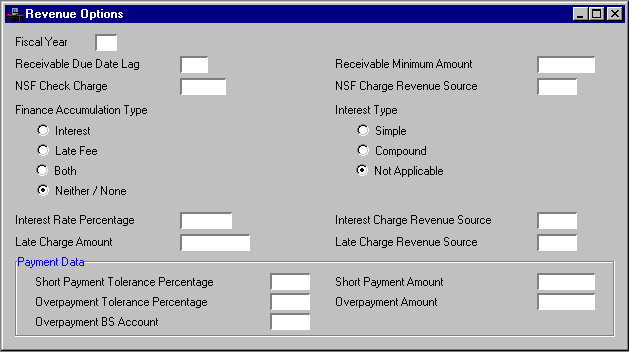|
|
|
|
Fiscal Year
|
Required. Enter the fiscal year for which the revenue options are valid.
|
|
Receivable Due Date Lag
|
Required. Enter the number of days past the receivable accept date or statement cutoff date that the receivable or statement is due.
|
|
Receivable Minimum Amount
|
Required. Enter the minimum allowable receivable amount. Receivable (RE) documents are rejected if the document total is less than this value.
|
|
NSF Check Charge
|
Required. Enter the standard charge applied against a customer's account for non-sufficient funds (NSF) checks.
|
|
NSF Charge Revenue Source
|
Required. Enter the revenue source used to accumulate non-sufficient funds (NSF) check charges.
|
|
Finance Accumulation Type
|
Defaults to
Neither/None [N]
. Defines the type of finance charge applied against delinquent receivable lines. Valid values are:
Interest [I]
Late Fee [L]
Both [B]
Neither/None [N]
|
|
Interest Type
|
Defaults to
Not Applicable [blank]
. Required if
Finance Accumulation Type
is
Interest [I]
. This specifies whether
Simple [S]
or
Compound [C]
interest is accrued.
|
|
Interest Rate Percentage
|
Required if
Finance Accumulation Type
is
Interest [I]
. Enter the annual percentage interest rate applied against delinquent receivables.
|
|
Interest Charge Revenue Source
|
Required. Enter the revenue source used to accumulate interest charges applied to delinquent accounts.
|
|
Late Charge Amount
|
Conditional. Required if
Late Fee [L]
is selected in
Finance Accumulation Type
. Specify the amount of a one-time late charge applied against delinquent receivables.
|
|
Late Charge Revenue Source
|
Required. Enter the revenue source used to accumulate late charges applied to delinquent accounts.
|
Payment Data
|
|
Short Payment Tolerance Percentage
|
Required. Enter the maximum percentage of payment under the billed amount that you can enter and still have the system accept it as a full payment.
|
|
Short Payment Amount
|
Required. Enter the maximum dollar amount of payment under the billed amount that you can enter and still have the system accept it as a full payment.
|
|
Overpayment Tolerance Percentage
|
Required. Enter the maximum percentage of payment over the billed amount that you can enter and not create a credit balance on the receivable for the overpayment.
|
|
Overpayment Amount
|
Required. Enter the maximum dollar amount of payment over the billed amount you can enter and not create a credit balance on the receivable for the overpayment.
|
|
Overpayment BS Account
|
Required. Enter the balance sheet account used to accumulate customer credits due to a customer overpayment outside of tolerance. See Balance Sheet Account Index (BACC) for valid values. Ensure that it is a liability account type and not a cash account.
|




